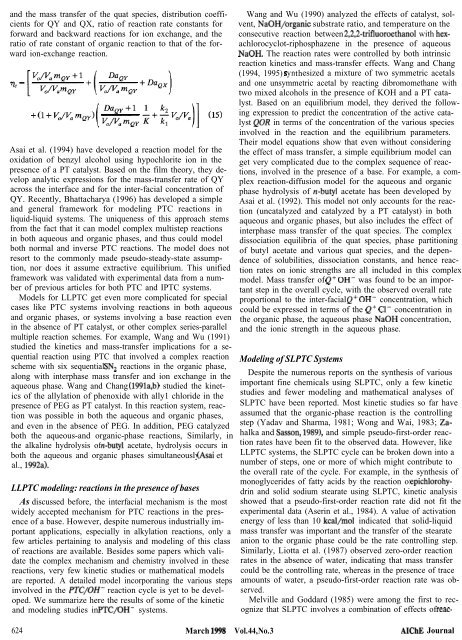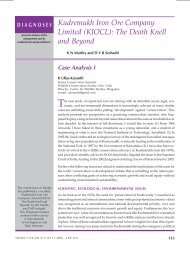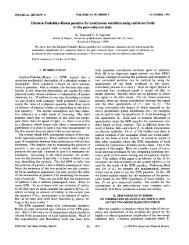Phase Transfer Catalysis - Publications of the IAS Fellows
Phase Transfer Catalysis - Publications of the IAS Fellows
Phase Transfer Catalysis - Publications of the IAS Fellows
Create successful ePaper yourself
Turn your PDF publications into a flip-book with our unique Google optimized e-Paper software.
and <strong>the</strong> mass transfer <strong>of</strong> <strong>the</strong> quat species, distribution coefficients<br />
for QY and QX, ratio <strong>of</strong> reaction rate constants for<br />
forward and backward reactions for ion exchange, and <strong>the</strong><br />
ratio <strong>of</strong> rate constant <strong>of</strong> organic reaction to that <strong>of</strong> <strong>the</strong> forward<br />
ion-exchange reaction.<br />
Asai et al. (1994) have developed a reaction model for <strong>the</strong><br />
oxidation <strong>of</strong> benzyl alcohol using hypochlorite ion in <strong>the</strong><br />
presence <strong>of</strong> a PT catalyst. Based on <strong>the</strong> film <strong>the</strong>ory, <strong>the</strong>y develop<br />
analytic expressions for <strong>the</strong> mass-transfer rate <strong>of</strong> QY<br />
across <strong>the</strong> interface and for <strong>the</strong> inter-facial concentration <strong>of</strong><br />
QY. Recently, Bhattacharya (1996) has developed a simple<br />
and general framework for modeling PTC reactions in<br />
liquid-liquid systems. The uniqueness <strong>of</strong> this approach stems<br />
from <strong>the</strong> fact that it can model complex multistep reactions<br />
in both aqueous and organic phases, and thus could model<br />
both normal and inverse PTC reactions. The model does not<br />
resort to <strong>the</strong> commonly made pseudo-steady-state assumption,<br />
nor does it assume extractive equilibrium. This unified<br />
framework was validated with experimental data from a number<br />
<strong>of</strong> previous articles for both PTC and IPTC systems.<br />
Models for LLPTC get even more complicated for special<br />
cases like PTC systems involving reactions in both aqueous<br />
and organic phases, or systems involving a base reaction even<br />
in <strong>the</strong> absence <strong>of</strong> PT catalyst, or o<strong>the</strong>r complex series-parallel<br />
multiple reaction schemes. For example, Wang and Wu (1991)<br />
studied <strong>the</strong> kinetics and mass-transfer implications for a sequential<br />
reaction using PTC that involved a complex reaction<br />
scheme with six sequential SNZ reactions in <strong>the</strong> organic phase,<br />
along with interphase mass transfer and ion exchange in <strong>the</strong><br />
aqueous phase. Wang and Chang (199la,b) studied <strong>the</strong> kinetics<br />
<strong>of</strong> <strong>the</strong> allylation <strong>of</strong> phenoxide with ally1 chloride in <strong>the</strong><br />
presence <strong>of</strong> PEG as PT catalyst. In this reaction system, reaction<br />
was possible in both <strong>the</strong> aqueous and organic phases,<br />
and even in <strong>the</strong> absence <strong>of</strong> PEG. In addition, PEG catalyzed<br />
both <strong>the</strong> aqueous-and organic-phase reactions, Similarly, in<br />
<strong>the</strong> alkaline hydrolysis <strong>of</strong> n-butyl acetate, hydrolysis occurs in<br />
both <strong>the</strong> aqueous and organic phases simultaneously (Asai et<br />
al., 1992a).<br />
LLPTC modeling: reactions in <strong>the</strong> presence <strong>of</strong> bases<br />
As discussed before, <strong>the</strong> interfacial mechanism is <strong>the</strong> most<br />
widely accepted mechanism for PTC reactions in <strong>the</strong> presence<br />
<strong>of</strong> a base. However, despite numerous industrially important<br />
applications, especially in alkylation reactions, only a<br />
few articles pertaining to analysis and modeling <strong>of</strong> this class<br />
<strong>of</strong> reactions are available. Besides some papers which validate<br />
<strong>the</strong> complex mechanism and chemistry involved in <strong>the</strong>se<br />
reactions, very few kinetic studies or ma<strong>the</strong>matical models<br />
are reported. A detailed model incorporating <strong>the</strong> various steps<br />
involved in <strong>the</strong> prC/QH- reaction cycle is yet to be developed.<br />
We summarize here <strong>the</strong> results <strong>of</strong> some <strong>of</strong> <strong>the</strong> kinetic<br />
and modeling studies in PTC/OH- systems.<br />
Wang and Wu (1990) analyzed <strong>the</strong> effects <strong>of</strong> catalyst, solvent,<br />
NaOH/organic substrate ratio, and temperature on <strong>the</strong><br />
consecutive reaction between 2,2,2-trifluoroethanol with hexachlorocyclot-riphosphazene<br />
in <strong>the</strong> presence <strong>of</strong> aqueous<br />
NaOH. The reaction rates were controlled by both intrinsic<br />
reaction kinetics and mass-transfer effects. Wang and Chang<br />
(1994, 1995) syn<strong>the</strong>sized a mixture <strong>of</strong> two symmetric acetals<br />
and one unsymmetric acetal by reacting dibromomethane with<br />
two mixed alcohols in <strong>the</strong> presence <strong>of</strong> KOH and a PT catalyst.<br />
Based on an equilibrium model, <strong>the</strong>y derived <strong>the</strong> following<br />
expression to predict <strong>the</strong> concentration <strong>of</strong> <strong>the</strong> active catalyst<br />
Q0R in terms <strong>of</strong> <strong>the</strong> concentration <strong>of</strong> <strong>the</strong> various species<br />
involved in <strong>the</strong> reaction and <strong>the</strong> equilibrium parameters.<br />
Their model equations show that even without considering<br />
<strong>the</strong> effect <strong>of</strong> mass transfer, a simple equilibrium model can<br />
get very complicated due to <strong>the</strong> complex sequence <strong>of</strong> reactions,<br />
involved in <strong>the</strong> presence <strong>of</strong> a base. For example, a complex<br />
reaction-diffusion model for <strong>the</strong> aqueous and organic<br />
phase hydrolysis <strong>of</strong> n-butyl acetate has been developed by<br />
Asai et al. (1992). This model not only accounts for <strong>the</strong> reaction<br />
(uncatalyzed and catalyzed by a PT catalyst) in both<br />
aqueous and organic phases, but also includes <strong>the</strong> effect <strong>of</strong><br />
interphase mass transfer <strong>of</strong> <strong>the</strong> quat species. The complex<br />
dissociation equilibria <strong>of</strong> <strong>the</strong> quat species, phase partitioning<br />
<strong>of</strong> butyl acetate and various quat species, and <strong>the</strong> dependence<br />
<strong>of</strong> solubilities, dissociation constants, and hence reaction<br />
rates on ionic strengths are all included in this complex<br />
model. Mass transfer <strong>of</strong> Q+ OH- was found to be an important<br />
step in <strong>the</strong> overall cycle, with <strong>the</strong> observed overall rate<br />
proportional to <strong>the</strong> inter-facial Q+ OH- concentration, which<br />
could be expressed in terms <strong>of</strong> <strong>the</strong> Q+ Cl- concentration in<br />
<strong>the</strong> organic phase, <strong>the</strong> aqueous phase NaOH concentration,<br />
and <strong>the</strong> ionic strength in <strong>the</strong> aqueous phase.<br />
Modeling <strong>of</strong> SLPTC Systems<br />
Despite <strong>the</strong> numerous reports on <strong>the</strong> syn<strong>the</strong>sis <strong>of</strong> various<br />
important fine chemicals using SLPTC, only a few kinetic<br />
studies and fewer modeling and ma<strong>the</strong>matical analyses <strong>of</strong><br />
SLPTC have been reported. Most kinetic studies so far have<br />
assumed that <strong>the</strong> organic-phase reaction is <strong>the</strong> controlling<br />
step (Yadav and Sharma, 1981; Wong and Wai, 1983; Zahalka<br />
and Sasson, 1989), and simple pseudo-first-order reaction<br />
rates have been fit to <strong>the</strong> observed data. However, like<br />
LLPTC systems, <strong>the</strong> SLPTC cycle can be broken down into a<br />
number <strong>of</strong> steps, one or more <strong>of</strong> which might contribute to<br />
<strong>the</strong> overall rate <strong>of</strong> <strong>the</strong> cycle. For example, in <strong>the</strong> syn<strong>the</strong>sis <strong>of</strong><br />
monoglycerides <strong>of</strong> fatty acids by <strong>the</strong> reaction <strong>of</strong> epichlorohydrin<br />
and solid sodium stearate using SLPTC, kinetic analysis<br />
showed that a pseudo-first-order reaction rate did not fit <strong>the</strong><br />
experimental data (Aserin et al., 1984). A value <strong>of</strong> activation<br />
energy <strong>of</strong> less than 10 kcal/mol indicated that solid-liquid<br />
mass transfer was important and <strong>the</strong> transfer <strong>of</strong> <strong>the</strong> stearate<br />
anion to <strong>the</strong> organic phase could be <strong>the</strong> rate controlling step.<br />
Similarly, Liotta et al. (1987) observed zero-order reaction<br />
rates in <strong>the</strong> absence <strong>of</strong> water, indicating that mass transfer<br />
could be <strong>the</strong> controlling rate, whereas in <strong>the</strong> presence <strong>of</strong> trace<br />
amounts <strong>of</strong> water, a pseudo-first-order reaction rate was observed.<br />
Melville and Goddard (1985) were among <strong>the</strong> first to recognize<br />
that SLPTC involves a combination <strong>of</strong> effects <strong>of</strong> reac-<br />
624 March 198 Vol. 44, No. 3 AIChE Journal
















